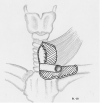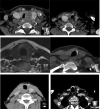From the clavicle to the windpipe: Tracheal window resections reconstructed with calcifying periosteum in thyroid cancer
- PMID: 33134546
- PMCID: PMC7585236
- DOI: 10.1002/lio2.463
From the clavicle to the windpipe: Tracheal window resections reconstructed with calcifying periosteum in thyroid cancer
Abstract
Objectives: We aimed to evaluate the outcomes of tracheal window resection and reconstruction using a vascularized periosteal flap (intended for calcification) harvested from the medial clavicle. This is one of several surgical techniques for tracheal resection and reconstruction used for patients with thyroid carcinoma invading the trachea. Importantly, in partial tracheal resection postoperative dynamic airway collapse must be prevented. Reconstruction of the tracheal defect with a vascularized periosteal flap is one method of achieving a stable airway.
Methods: Twelve patients with locally advanced thyroid carcinoma who underwent tracheal resection and reconstruction at Oslo University Hospital from 2004 to 2017 were studied retrospectively. The primary outcome was a stable airway not requiring airway stenting. The secondary outcomes were the time to decannulation, morbidity, and survival.
Results: Eleven of 12 patients did not require airway stenting postoperatively after a median of 111 days. Seven patients developed postoperative complications. The median observation time was 74.8 months (range 10.5-153.5) for all patients. The median disease-free survival was 40 months (range 0-147). By February 1, 2020, seven patients were alive, of whom five showed no evidence of disease.
Conclusions: Tracheal reconstruction with a vascularized periosteal flap yielded good results in terms of establishing a stable airway. This procedure is a viable reconstructive option that allows for decannulation by preventing airway collapse, thereby potentially mitigating the need for end-to-end (ETE) anastomosis or sleeve resections. For selected patients, this procedure may prevent local fatal complications from thyroid cancer invading the trachea.
Level of evidence: Level 4.
Keywords: thyroid neoplasms/surgery; thyroidectomy/methods; tracheal resection; treatment outcome.
© 2020 The Authors. Laryngoscope Investigative Otolaryngology published by Wiley Periodicals LLC on behalf of The Triological Society.
Conflict of interest statement
The authors declare no potential conflict of interest.
Figures






Similar articles
-
Tracheal window resection and reconstruction via sternocleidomastoid flap for invasive thyroid carcinoma.Interact Cardiovasc Thorac Surg. 2021 Nov 22;33(6):899-904. doi: 10.1093/icvts/ivab193. Interact Cardiovasc Thorac Surg. 2021. PMID: 34293120 Free PMC article.
-
[Surgical treatment of well-differentiated thyroid carcinoma invading trachea: a report of 15 cases].Ai Zheng. 2004 Nov;23(11 Suppl):1498-501. Ai Zheng. 2004. PMID: 15566666 Chinese.
-
Autologous tracheal replacement: from research to clinical practice.Presse Med. 2013 Sep;42(9 Pt 2):e334-41. doi: 10.1016/j.lpm.2013.07.003. Epub 2013 Aug 29. Presse Med. 2013. PMID: 23993275
-
Complications from tracheal resection for thyroid carcinoma.Gland Surg. 2017 Oct;6(5):574-578. doi: 10.21037/gs.2017.08.05. Gland Surg. 2017. PMID: 29142850 Free PMC article. Review.
-
Surgery for Thyroid Cancer Invading the Trachea.Indian J Surg Oncol. 2022 Mar;13(1):184-190. doi: 10.1007/s13193-021-01466-7. Epub 2021 Oct 27. Indian J Surg Oncol. 2022. PMID: 35462665 Free PMC article. Review.
Cited by
-
Tracheal window resection and reconstruction via sternocleidomastoid flap for invasive thyroid carcinoma.Interact Cardiovasc Thorac Surg. 2021 Nov 22;33(6):899-904. doi: 10.1093/icvts/ivab193. Interact Cardiovasc Thorac Surg. 2021. PMID: 34293120 Free PMC article.
-
A novel classification of tracheal defects and the reconstruction strategies: A retrospective study based on 106 cases.World J Otorhinolaryngol Head Neck Surg. 2022 Apr 29;9(1):66-73. doi: 10.1016/j.wjorl.2021.08.001. eCollection 2023 Mar. World J Otorhinolaryngol Head Neck Surg. 2022. PMID: 37006741 Free PMC article.
References
-
- Brauckhoff M. Classification of aerodigestive tract invasion from thyroid cancer. Langenbecks Arch Surg. 2014;399:209‐216. - PubMed
-
- Urken ML. Prognosis and management of invasive well‐differentiated thyroid cancer. Otolaryngol Clin North Am. 2010;43:301‐328. viii. - PubMed
-
- Honings J, Stephen AE, Marres HA, Gaissert HA. The management of thyroid carcinoma invading the larynx or trachea. Laryngoscope. 2010;120:682‐689. - PubMed
-
- Shindo ML, Caruana SM, Kandil E, et al. Management of invasive well‐differentiated thyroid cancer: an American head and neck society consensus statement. AHNS consensus statement. Head Neck. 2014;36:1379‐1390. - PubMed
LinkOut - more resources
Full Text Sources
Research Materials
